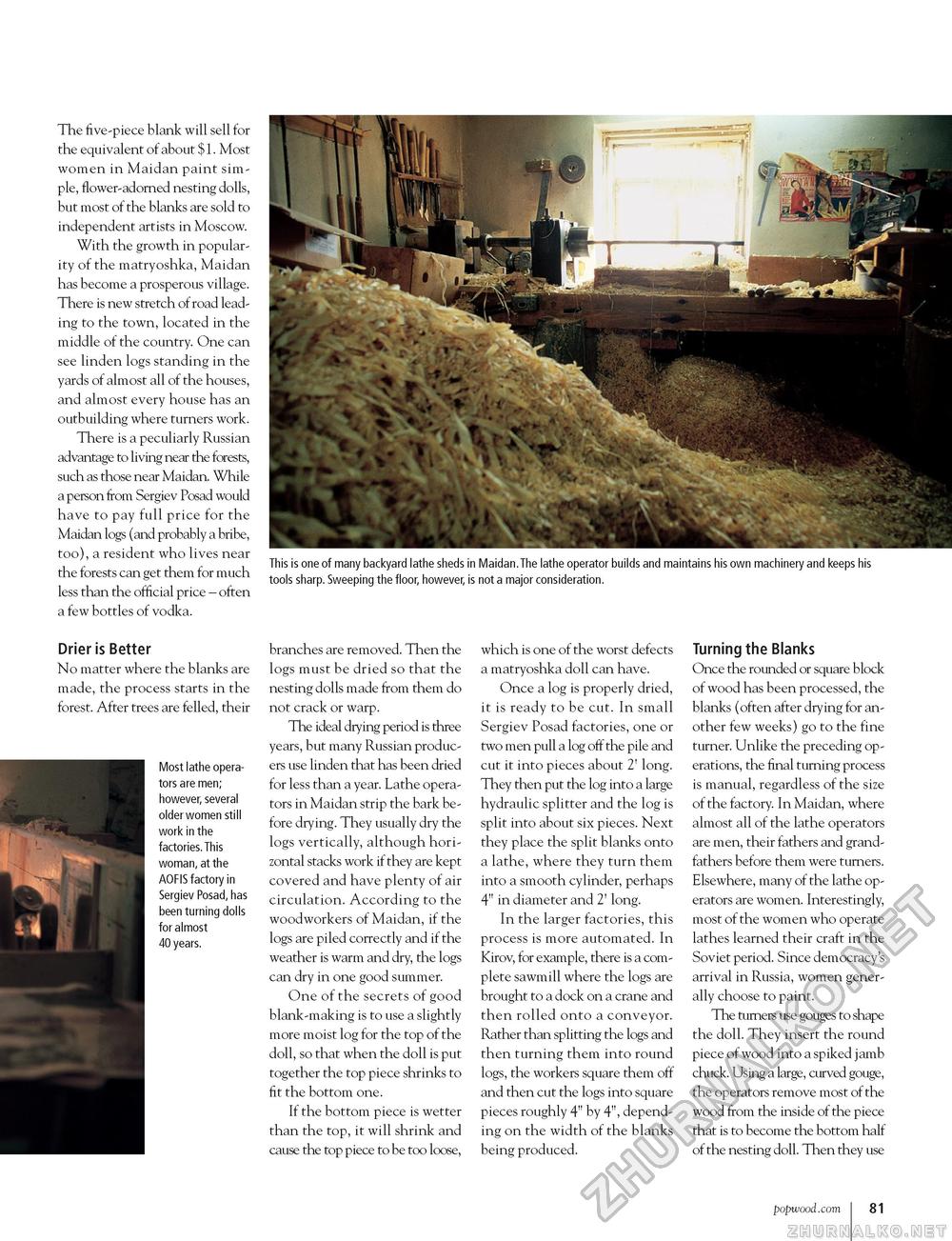Popular Woodworking 2003-10 № 136, страница 81
The five-piece blank will sell for the equivalent of about $1. Most women in Maidan paint simple, flower-adorned nesting dolls, but most of the blanks are sold to independent artists in Moscow. With the growth in popularity of the matryoshka, Maidan has become a prosperous village. There is new stretch of road leading to the town, located in the middle of the country. One can see linden logs standing in the yards of almost all of the houses, and almost every house has an outbuilding where turners work. There is a peculiarly Russian advantage to living near the forests, such as those near Maidan. While a person from Sergiev Posad would have to pay full price for the Maidan logs (and probably a bribe, too), a resident who lives near the forests can get them for much less than the official price - often a few bottles of vodka. This is one of many backyard lathe sheds in Maidan.The lathe operator builds and maintains his own machinery and keeps his tools sharp. Sweeping the floor, however, is not a major consideration. Drier is Better No matter where the blanks are made, the process starts in the forest. After trees are felled, their Most lathe operators are men; however, several older women still work in the factories. This woman, at the AOFIS factory in Sergiev Posad, has been turning dolls for almost 40 years. branches are removed. Then the logs must be dried so that the nesting dolls made from them do not crack or warp. The ideal drying period is three years, but many Russian producers use linden that has been dried for less than a year. Lathe operators in Maidan strip the bark before drying. They usually dry the logs vertically, although horizontal stacks work if they are kept covered and have plenty of air circulation. According to the woodworkers of Maidan, if the logs are piled correctly and if the weather is warm and dry, the logs can dry in one good summer. One of the secrets of good blank-making is to use a slightly more moist log for the top of the doll, so that when the doll is put together the top piece shrinks to fit the bottom one. If the bottom piece is wetter than the top, it will shrink and cause the top piece to be too loose, which is one of the worst defects a matryoshka doll can have. Once a log is properly dried, it is ready to be cut. In small Sergiev Posad factories, one or two men pull a log off the pile and cut it into pieces about 2' long. They then put the log into a large hydraulic splitter and the log is split into about six pieces. Next they place the split blanks onto a lathe, where they turn them into a smooth cylinder, perhaps 4" in diameter and 2' long. In the larger factories, this process is more automated. In Kirov, for example, there is a complete sawmill where the logs are brought to a dock on a crane and then rolled onto a conveyor. Rather than splitting the logs and then turning them into round logs, the workers square them off and then cut the logs into square pieces roughly 4" by 4", depending on the width of the blanks being produced. Turning the Blanks Once the rounded or square block of wood has been processed, the blanks (often after drying for another few weeks) go to the fine turner. Unlike the preceding operations, the final turning process is manual, regardless of the size of the factory. In Maidan, where almost all of the lathe operators are men, their fathers and grandfathers before them were turners. Elsewhere, many of the lathe operators are women. Interestingly, most of the women who operate lathes learned their craft in the Soviet period. Since democracy's arrival in Russia, women generally choose to paint. The turners use gouges to shape the doll. They insert the round piece of wood into a spiked jamb chuck. Using a large, curved gouge, the operators remove most of the wood from the inside of the piece that is to become the bottom half of the nesting doll. Then they use popwood.com 81 |








